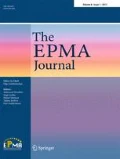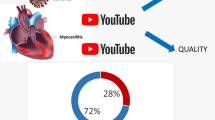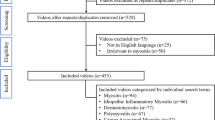Abstract
Introduction
There is a paucity of data pertaining to the usefulness of information presented on social media platforms on chronic neuropsychiatric conditions such as Parkinson’s disease (PD). The aim of this study was to examine the quality of YouTube™ videos that deliver general information on PD and the availability and design of instructional videos addressing the caregiving role in PD.
Methods
YouTube™ was searched using the keyword “Parkinson’s disease” for relevant videos. Videos were assessed for usefulness and accuracy based on pre-defined criteria. Data on video characteristics including total viewership, duration, ratings, and source of videos were collated. Instructional PD videos that addressed the role of caregivers were examined closely for the design and scope of instructional content.
Results
A total of 100 videos met the inclusion criteria. Just under a third of videos (28%) was uploaded by trusted academic organisations. Overall, 15% of PD videos were found to be somewhat useful and only 4% were assessed as providing very useful PD information; 3% of surveyed videos were misleading. The mean number of video views (regardless of video source) was not significantly different between the different video ratings (p = 0.86). Although personal videos trended towards being less useful than videos from academic organisations, this association was not statistically significant (p = 0.13).
Conclusion
To our knowledge, this is the first study to assess the usefulness of PD information on the largest video-sharing website, YouTube™. In general, the overall quality of information presented in the videos screened was mediocre. Viewership of accurate vs. misleading information was, however, very similar. Therefore, healthcare providers should direct PD patients and their families to the resources that provide reliable and accurate information.
Similar content being viewed by others
Introduction
Epidemiological and demographic transitions in developed and developing countries have resulted in a rise in the prevalence of non-communicable diseases (NCDs) worldwide. As a consequence, NCD has become the leading cause of death and non-fatal health loss globally, a significant part of which is attributable to neurological disorders [1].
Parkinson’s disease (PD) is the second most common neurodegeneration disease, surpassed only by Alzheimer’s disease [2]. The disease takes a relentless and progressive course, resulting in motor [2] and non-motor manifestations including autonomic dysfunction [3], anxiety, depression, and dementia [4]. Despite the advances made in medical and surgical treatments, there remains no cure. It is estimated that upwards of 10 million people worldwide are afflicted with PD [5].
A large and rapidly growing body of literature has investigated the use of social media, defined as a group of online applications which allow for the exchange of unverified user-generated information, among patients and caregivers as a source of health information [6]. YouTube™, for example, has been shown to serve as a rather popular and appealing source of freely available information for a variety of emerging (e.g. H1N1 influenza [7] and Ebola virus disease [8]), acute (e.g. nephrolithiasis [9]), and chronic (e.g. diabetic foot [10]) medical conditions. However, there is a paucity of data pertaining to the accuracy of information presented on social media platforms, especially with regard to chronic neuropsychiatric conditions.
A large proportion of caregivers access the Internet seeking health information related to the care of their relatives and loved ones [11]. PD is a chronic physically debilitating disorder with a multitude of motor and non-motor symptoms, the management of which can be complex. Moreover, unlike other previously studied conditions, such as hypertension and kidney stones, PD information on social media is likely geared towards patients and their families who often carry the burden of caregiving. Therefore, family members/caregivers’ education about the day-to-day care of PD patients may obviate stress, anxiety, and seeking erroneous and misleading information.
Previous analysis of the quality of videos on YouTube™ on schizophrenia has shown indiscriminate viewer reception between high-quality and misleading videos [12]. The aim of the current study was to examine the quality of YouTube™ as a general information source on PD and assess the patterns of viewership of videos on the subject. Furthermore, the availability and design of instructional PD videos aimed at caregivers addressing their role in caring for PD patients were evaluated.
Methods
Study setting
YouTube™ (www.youtube.com) was searched for videos using the keyword “Parkinson’s disease”. The discrepancy in YouTube™ search results using closely related terms (e.g. Parkinson disease vs. Parkinson’s disease) has previously been shown to be negligible [13]. To control for a potential search history effect, the search history was deleted in a computer and the search was then conducted using a newly loaded web browser (Google Chrome™).
Video characteristics
Only videos in the English language under 30 min’ duration within the first six pages of search results were included in this study. Duplicate videos, sponsored advertisements, and videos longer than 30 min were excluded.
Rating criteria
A total of eight general statements pertaining to PD were obtained from the patient information pages of three trusted websites (PD Foundation [5], Michael J. Fox Foundation [14], and the National Institute of Neurological Disorders and Stroke [15]); these were used as the basis for the PD statements.
Usefulness of videos was decided based upon the number of fulfilled statements as mentioned in the video; similar criteria have been adopted in previous studies [7, 9, 10]. PD statements were grouped into five usefulness categories: very useful (6–8), somewhat useful (3–5), not very useful (1–2), not at all useful (0), and misleading. Misleading videos were defined as those containing false or scientifically unproven information (e.g. reversing PD using herbal supplements). Other relevant video characteristics including total viewership, duration, and source were also recorded. The different video-uploading users were categorised as: academic organisations (i.e. universities, research institutes, and trusted governmental/non-governmental organisations), news agencies, and personal (e.g. anecdotal experiences, personal analyses, or advertisements) (Table 1).
Videos meeting inclusion criteria were independently evaluated for usefulness and classified accordingly by two clinician authors (ISA and YA) with experience in PD research. Any disagreement between the reviewers was resolved through discussion.
Instructional videos
Of the retrieved videos, those with instructional content that addressed the role of caregivers in PD patient care and management was examined more closely. Instructional videos were defined as those providing information or suggestions on how to do something or what to do in a certain situation [16]. Properties of good instructional videos include forecasting goals and steps, demonstrative content (i.e. steps and processes are both performed and explained or elaborated), and content with easily understood and engaging agenda. The role of persons speaking and appearing in videos was recorded as patients (real and simulated), caregivers (real and simulated), or healthcare professionals (doctors, nurses, and allied healthcare professionals). The design of instructional videos was evaluated by examining the frame of instruction within the video. Instructional frames were classified into three categories, as suggested by Morain and Swarts [17]: explanation (instructional talk with no onscreen actions), demonstration (onscreen action to illustrate a process/step, accompanied by explanation), or doing (onscreen action to illustrate a process/step, not accompanied by explanation). The making of identified instructional videos was categorised according to Weaver and colleagues [18] into user-generated amateur, user-generated professional, recording of unedited mainstream media, and recording of user-edited mainstream media. Given that PD caregivers are usually family members with no medical background, the use of appropriate literacy and communication tools that aid in delivering a clear instructional message was assessed using the Federal Plain Language Guidelines [19]. Literacy and communication aids include examples (verbal or visual), lists, tables, illustrations (i.e. pictures, charts, graphs, maps), and emphasis to highlight important concepts. Finally, the accuracy of instructional content within identified videos was evaluated using the above-mentioned criteria.
Statistical analysis
Descriptive analyses were utilised for the bulk of the data. One-way ANOVA analysis was used to examine differences between the video categories. Statistical significance was determined if type I error rate was < 5%. Inter-rater agreement was determined by using Cohen’s kappa score. All analyses were performed using SPSS Statistics® software package (version 22.0.0.0).
Results
A total of 112 videos were screened, of which, 100 met the inclusion criteria. The total duration of reviewed material was 761 min. The combined viewership of all videos was 15.4 million views. The mean duration of the videos was 7.6 min (± 6.3), with a mean viewership of 154,207 (± 467,907) views per video. Inter-rater agreement was 91%.
The source of most videos was personal users. Although personal videos trended towards being less useful than videos from academic organisations, this association was not statistically significant (p = 0.13). See Table 2 for details.
Detailed analysis of viewed videos is shown in Table 3. Importantly, the mean number of video views (regardless of video source) was not significantly different between the different video ratings (p = 0.86).
Of the 100 videos that met the inclusion criteria, eight (8%) videos met the instructional definition. The total duration of content was 65.1 min (mean 8.1, SD ± 8 min) with a combined viewership of 1.2 million views (range 10,559–620,499). Four videos were user-generated amateur videos while the other four videos were user-generated professional videos.
Most instructional videos were framed as a demonstration (n = 6), followed by explanation where the content is instructional talk with no onscreen action. All videos featured a patient (7 real, 1 simulated), with only three videos portrayed a caregiver (2 real, 1 simulated) and a healthcare professional. Examples were the most commonly utilised literacy tool (n = 7), followed by lists (n = 3). The majority of instructional videos were assessed as either not at all useful or misleading (n = 5), while only one video was characterised as very useful. The content of misleading videos primarily revolved around the speculations of then-presidential candidate Hillary Clinton manifesting early symptoms of PD and the role of supplements, complementary, and alternative medicines in reversing PD.
Discussion
This study is the first to systematically assess the accuracy and usefulness of PD information on the social media platform, YouTube™. Overall, 15% of PD videos were found to be somewhat useful and only 4% were assessed as providing very useful PD information. This finding is consistent with previous studies examining the quality of YouTube™ videos relating to several medical conditions [7,8,9,10, 12].
Personal users uploaded the majority of reviewed videos (66%). While this fulfils the purpose of such platforms as YouTube™ (i.e. an online user-generated video resource), video scientific content is not rigorously scrutinised. In fact, all misleading videos (3%) were uploaded by personal users.
Videos from trusted academic sources (universities, research institutes, and governmental agencies and non-governmental organisations), on the other hand, were under-represented (28% of total videos). Of videos uploaded by trusted academic organisations, only five (17.9%) were characterised as somewhat useful or very useful (see Table 2).
Our analysis of videos aimed at caregivers revealed disappointing results. Caregivers of such patients as those of PD are particularly prone to carer-strain, due to the chronicity of their loved one’s illness and the likelihood of gradual deterioration (especially in cognition). Trustworthy information that is easily accessible can (e.g. Wikipedia or YouTube™) help in providing carers with strategies on how to deal with their loved ones’ illness, how to cope with the stress, and when/where to ask for help.
Our findings have relevant implications for PD patients, their families and health care providers. YouTube™ is the largest video-sharing social media platform, and the second most popular website on the Internet (behind Google™), with over a billion users worldwide [20, 21]. Given the wide popularity and easy accessibility of YouTube™ to users across the globe, PD organisations such as the PD Foundation [5], Michael J. Fox Foundation [14], and National Institute of Neurological Disorders and Stroke [15] should increase their efforts to disseminate high-quality, accurate PD information on such popular social media platforms. This, in turn, can curtail the dissemination and popularisation of misleading pseudo-scientific material posted by personal/independent sources.
There are several limitations to this study. The usefulness and accuracy of PD information reported on YouTube™ were assessed based on subjective pre-defined criteria. The utilised criteria, however, represented the most common pieces of information presented to patients by trusted PD organisations [5, 14, 15]. The utilised criteria have been clinically oriented, which could have disadvantaged rating the usefulness of videos by patients and caregivers. Additionally, our study only examined the quality of PD information on one social media outlet, and thus, findings from this study should not be generalised to other social media platforms (e.g. Facebook™ or Twitter, Inc.).
Conclusion
In conclusion, YouTube™ affords an easily accessible source of accurate PD information if judiciously used. The overall quality of such information is, by and large, mediocre. With the absence of restrictions on the type and quality PD videos uploaded on YouTube™, health care providers should direct PD patients and their families to the resources that provide reliable and accurate information.
References
GBD 2015 DALYs and HALE Collaborators. Global, regional, and national disability-adjusted life-years (DALYs) for 315 diseases and injuries and healthy life expectancy (HALE), 1990–2015: a systematic analysis for the Global Burden of Disease Study 2015. Lancet. 2016;388:1603–58.
Hirsch L, Jette N, Frolkis A, Steeves T, Pringsheim T. The incidence of Parkinson’s disease: a systematic review and meta-analysis. Neuroepidemiology. 2016;46:292–300.
De Pablo-Fernandez E, Tur C, Revesz T, Lees AJ, Holton JL, Warner TT. Association of autonomic dysfunction with disease progression and survival in Parkinson disease. JAMA Neurol. 2017;74:970–6. https://doi.org/10.1001/jamaneurol.2017.1125.
Barone P, Antonini A, Colosimo C, Marconi R, Morgante L, Avarello TP, et al. The PRIAMO study: a multicenter assessment of nonmotor symptoms and their impact on quality of life in Parkinson’s disease. Mov Disord. 2009;24:1641–9. https://doi.org/10.1002/mds.22643.
Parkinson’s Disease Foundation. Statistics on Parkinson’s. 2016. Available from: http://www.pdf.org/en/parkinson_statistics. Accessed 6 Dec 2016.
Hamm MP, Chisholm A, Shulhan J, Milne A, Scott SD, Given LM, et al. Social media use among patients and caregivers: a scoping review. BMJ Open. 2013;3:e002819.
Pandey A, Patni N, Singh M, Sood A, Singh G. YouTube as a source of information on the H1N1 influenza pandemic. Am J Prev Med. 2010;38:e1–3.
Pathak R, Poudel DR, Karmacharya P, Pathak A, Aryal MR, Mahmood M, et al. YouTube as a source of information on Ebola virus disease. N Am J Med Sci. 2015;7:306–9.
Sood A, Sarangi S, Pandey A, Murugiah K. YouTube as a source of information on kidney stone disease. Urology. 2011;77:558–62.
Abedin T, Ahmed S, Al Mamun M, Ahmed SW, Newaz S, Rumana N, et al. YouTube as a source of useful information on diabetes foot care. Diabetes Res Clin Pract. 2015;110:e1–4.
Fox S, Brenner J. Family caregivers online. Pew Research Center, Washington, DC. 2012. Available from: http://www.pewinternet.org/files/old-media/Files/Reports/2012/PIP_Family_Caregivers_Online.pdf. Accessed 2 May 2017.
Nour MM, Nour MH, Tsatalou OM, Barrera A. Schizophrenia on YouTube. Psychiatr Serv. 2016;68:70–4. https://doi.org/10.1176/appi.ps.201500541.
Tao D, Adsul P, Wray R, Jupka K, Semar C, Goggins K. Search strategy effectiveness and relevance of YouTube videos. Proc Assoc Inf Sci Technol. 2012;49:1–4.
The Michael J. Fox Foundation for Parkinson's Research. Understanding Parkinson’s. 2017. Available from: https://www.michaeljfox.org/understanding-parkinsons/index.html?navid=understanding-pd. Accessed 5 Aug 2017.
National Institute of Neurological Disorders and Stroke. Parkinson’s Disease Information Page. 2017. Available from: https://www.ninds.nih.gov/Disorders/All-Disorders/Parkinsons-Disease-Information-Page. Accessed 5 Aug 2017.
Swarts J. New modes of help: best practices for instructional video. Tech Commun. 2012;59:195–206.
Morain M, Swarts J. YouTutorial: a framework for assessing instructional online video. Tech Commun Q. 2012;21:6–24.
Weaver B, Zelenkauskaite A, Samson L. The (non) violent world of YouTube: content trends in web video. Aust J Commun. 2012;62:1065–83.
Plain Language Action and Information Network. Federal Plain Language Guidelines. 2011. Available from: http://www.plainlanguage.gov/howto/guidelines/FederalPLGuidelines/FederalPLGuidelines.pdf. Accessed 2 May 2017.
Alexa Internet, Inc. The Top 500 Sites on the Web. 2017. Available from: http://www.alexa.com/topsites. Accessed 10 Dec 2016.
YouTube®. YouTube in numbers. 2017. Available from: https://www.youtube.com/yt/press/en-GB/statistics.html. Accessed 10 Dec 2016.
Funding
This research did not receive any specific grant from funding agencies in the public, commercial, or not-for-profit sectors.
Author information
Authors and Affiliations
Corresponding author
Ethics declarations
Conflict of interest
The authors declare that they have no conflict of interest.
Rights and permissions
Open Access This article is licensed under a Creative Commons Attribution 4.0 International License, which permits use, sharing, adaptation, distribution and reproduction in any medium or format, as long as you give appropriate credit to the original author(s) and the source, provide a link to the Creative Commons licence, and indicate if changes were made.
The images or other third party material in this article are included in the article’s Creative Commons licence, unless indicated otherwise in a credit line to the material. If material is not included in the article’s Creative Commons licence and your intended use is not permitted by statutory regulation or exceeds the permitted use, you will need to obtain permission directly from the copyright holder.
To view a copy of this licence, visit https://creativecommons.org/licenses/by/4.0/.
About this article
Cite this article
Al-Busaidi, I.S., Anderson, T.J. & Alamri, Y. Qualitative analysis of Parkinson’s disease information on social media: the case of YouTube™. EPMA Journal 8, 273–277 (2017). https://doi.org/10.1007/s13167-017-0113-7
Received:
Accepted:
Published:
Issue Date:
DOI: https://doi.org/10.1007/s13167-017-0113-7




